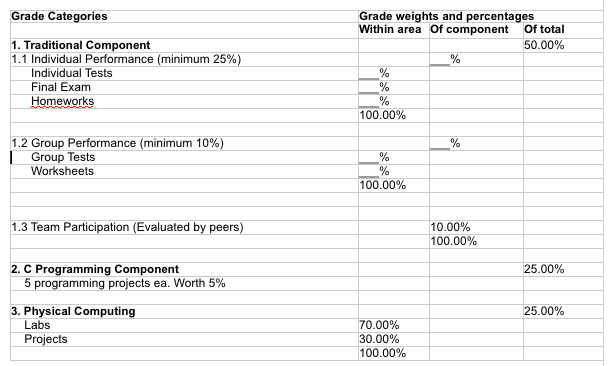Syllabus
General Info
Meeting times and location: MW 9-10:50 Trinkle B52
Credits: 4
Course website:
http://www.zacharski.org/classes/2010/spring/cs305/
Instructor:
Ron Zacharski
Trinkle B20
googletalk & gmail: ron.zacharski
aim: zacharsky
Office hours:
Tuesday: 1:45-3:30
Wednesday: 11-1
Thursday: 1:45-3:30
Required materials
Textbook: Yale N. Patt and Sanjay J. Patel. Introduction to Computing Systems: From bits & gates to C & beyond. McGraw Hill. ISBN-10: 0072467509
Components: an Arduino board or clone. Assortment of LEDs, resistors, wire. Breadboard.
Catalog description
This course provides an introduction to the basic operation of computing systems. The objective of the course is for students to understand the role played by each of the simple components of a computer.
Goals
- to understand the fundamentals of logic design
- to understand the basic concepts of computer systems.
- to gain ability in writing programs in machine language, assembly, and C.
- to develop basic skills in physical computing
- to gain experience working in teams and in meeting deadlines.
Format of course
Teams
During the first day of class, all students will be assigned to permanent teams. Throughout the course, teams will both take team tests and participate in joint activities. Team performance will be one component of your final grade.
Format of course – IMPORTANT
The structure of the course this semester is experimental. There will be three components: the traditional component, the C programming component, and the physical computing component. The traditional component, which makes up ½ the content of the course (and ½ of your grade) and covers the same amount of material at the same depth as taught in a traditional computer architecture class. The C programming component (¼ the course and grade) focuses on learning C and honing your problem solving skills. In class we will cover how C is different than other languages, but much of the work in this component will be done outside of class. The programming projects are short in terms of lines of code but extremely challenging. The physical computing component (¼ the course and grade) focuses on building devices that interact with the real world. Instead of traditional I/O (keyboard, mouse, displays, and printers) we will look at sensors and actuators. This component is hands on we will build devices and write software to control those devices.
Traditional Component
This consists of units of study roughly corresponding to the chapters of our textbook. The structure of each unit is as follows. First there will be an assigned reading. Depending on the unit, the reading might consist of as few as 20 pages to over 100. Following the reading, there will be a short multiple-choice test (the Readiness Assessment Test described below). We will then practice applying the material through homework assignments and in-class group labs. Finally, your team will complete a larger in-class project related to the study unit.
Readiness Assessment Tests and exams
There will be approximately six short multiple-choice Readiness Assessment Tests (RATs) given during the course. Each test will be taken individually and by team. On group exams and projects all team members will get the same grade. Makeup tests will not be given.
Grading
Team participation
Each student will rate the helpfulness of all members of their group. Individual group participation scores will be the sum of the points they receive from other members of their team. Each team member distributes 100 points to other members of the team. The average team participation score will be 100 points. The rater must differentiate some of their ratings (they cannot assign the same rating to all members).
Grading criteria and grading weights
Grading is on a straight scale. The grade reflects your achievement regardless of the performance of other students in the class. There is no curve. 93 and above is an A; 90-93 an A-; 80-89 a B; 70-79 a C; 65-70 a D; and 64 and below an F. If everyone in the class does poorly on a particular item (test, or assignment), we will identify the problem and determine a remedy. The grades will be determined by scores in three areas: individual performance, group performance, and group participation (as determined by peer evaluation). The percentage of the grade that is based on each area will be determined by representatives of each student team during the first class. The procedure is as follows:
- Each team sets preliminary weights by filling in the blanks in the table below and selects a representative for their group.
- Team representatives will meet at the front of the room and develop a consensus about the grade weights for the entire class.
Final Exam
TBA –
Accommodations for students with special needs
Any student with a documented disability may receive a special accommodation to complete any requirements of this course. If you are have a disability or believe you have one you may wish to self-identify. You may do so by providing documentation to the Office of Disability Services located in Room 203 of George Washington Hall (Phone: Voice 540-654-1266, Fax: 540-654-1163). Appropriate accommodations may then be provided for you. If you have a condition that may affect your ability to exit the premises in an emergency or that may cause an emergency during class, you are encouraged to discuss this in confidence with me and/or anyone at the Office of Disability Services. This office can also answer any questions you have about the Americans with Disabilities Act (ADA).
